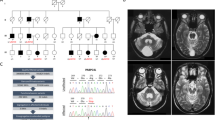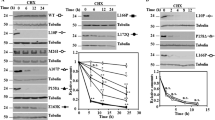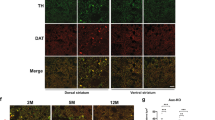Abstract
Neurodegenerative disorders such as Parkinson and Alzheimer disease cause motor and cognitive dysfunction and belong to a heterogeneous group of common and disabling disorders1. Although the complex molecular pathophysiology of neurodegeneration is largely unknown, major advances have been achieved by elucidating the genetic defects underlying mendelian forms of these diseases2. This has led to the discovery of common pathophysiological pathways such as enhanced oxidative stress, protein misfolding and aggregation and dysfunction of the ubiquitin-proteasome system3,4,5,6. Here, we describe loss-of-function mutations in a previously uncharacterized, predominantly neuronal P-type ATPase gene, ATP13A2, underlying an autosomal recessive form of early-onset parkinsonism with pyramidal degeneration and dementia (PARK9, Kufor-Rakeb syndrome7,8). Whereas the wild-type protein was located in the lysosome of transiently transfected cells, the unstable truncated mutants were retained in the endoplasmic reticulum and degraded by the proteasome. Our findings link a class of proteins with unknown function and substrate specificity9 to the protein networks implicated in neurodegeneration and parkinsonism.
This is a preview of subscription content, access via your institution
Access options
Subscribe to this journal
Receive 12 print issues and online access
$209.00 per year
only $17.42 per issue
Buy this article
- Purchase on Springer Link
- Instant access to full article PDF
Prices may be subject to local taxes which are calculated during checkout






Similar content being viewed by others
References
Nussbaum, R.L. & Ellis, C.E. Alzheimer's disease and Parkinson's disease. N. Engl. J. Med. 348, 1356–1364 (2003).
Vila, M. & Przedborski, S. Genetic clues to the pathogenesis of Parkinson's disease. Nat. Med. 10 (Suppl.), S58–S62 (2004).
Ciechanover, A. Proteolysis: from the lysosome to ubiquitin and the proteasome. Nat. Rev. Mol. Cell Biol. 6, 79–87 (2005).
Cookson, M.R. The biochemistry of Parkinson's disease. Annu. Rev. Biochem. 74, 29–52 (2005).
Dawson, T.M. & Dawson, V.L. Molecular pathways of neurodegeneration in Parkinson's disease. Science 302, 819–822 (2003).
Selkoe, D.J. Cell biology of protein misfolding: the examples of Alzheimer's and Parkinson's diseases. Nat. Cell Biol. 6, 1054–1061 (2004).
Najim al-Din, A.S., Wriekat, A., Mubaidin, A., Dasouki, M. & Hiari, M. Pallido-pyramidal degeneration, supranuclear upgaze paresis and dementia: Kufor-Rakeb syndrome. Acta Neurol. Scand. 89, 347–352 (1994).
Williams, D.R., Hadeed, A., Al-Din, A.S., Wreikat, A.L. & Lees, A.J. Kufor Rakeb Disease: Autosomal recessive, levodopa-responsive parkinsonism with pyramidal degeneration, supranuclear gaze palsy, and dementia. Mov. Disord. 20, 1264–1271 (2005).
Axelsen, K.B. & Palmgren, M.G. Evolution of substrate specificities in the P-type ATPase superfamily. J. Mol. Evol. 46, 84–101 (1998).
Hampshire, D.J. et al. Kufor-Rakeb syndrome, pallido-pyramidal degeneration with supranuclear upgaze paresis and dementia, maps to 1p36. J. Med. Genet. 38, 680–682 (2001).
Kitada, T. et al. Mutations in the parkin gene cause autosomal recessive juvenile parkinsonism. Nature 392, 605–608 (1998).
Bonifati, V. et al. DJ-1 (PARK7), a novel gene for autosomal recessive, early onset parkinsonism. Neurol. Sci. 24, 159–160 (2003).
Valente, E.M. et al. Hereditary early-onset Parkinson's disease caused by mutations in PINK1. Science 304, 1158–1160 (2004).
Kuhlbrandt, W. Biology, structure and mechanism of P-type ATPases. Nat. Rev. Mol. Cell Biol. 5, 282–295 (2004).
Schultheis, P.J. et al. Characterization of the P5 subfamily of P-type transport ATPases in mice. Biochem. Biophys. Res. Commun. 323, 731–738 (2004).
Kwasnicka-Crawford, D.A. et al. Characterization of a novel cation transporter ATPase gene (ATP13A4) interrupted by 3q25-q29 inversion in an individual with language delay. Genomics 86, 182–194 (2005).
Liss, B., Neu, A. & Roeper, J. The weaver mouse gain-of-function phenotype of dopaminergic midbrain neurons is determined by coactivation of wvGirk2 and K-ATP channels. J. Neurosci. 19, 8839–8848 (1999).
Liss, B. et al. Tuning pacemaker frequency of individual dopaminergic neurons by Kv4.3L and KChip3.1 transcription. EMBO J. 20, 5715–5724 (2001).
Liss, B. Improved quantitative real-time RT-PCR for expression profiling of individual cells. Nucleic Acids Res. 30, e89 (2002).
Schroeder, A. et al. The RIN: an RNA integrity number for assigning integrity values to RNA measurements. BMC Mol. Biol. 7, 3 (2006).
Rao, R.V. & Bredesen, D.E. Misfolded proteins, endoplasmic reticulum stress and neurodegeneration. Curr. Opin. Cell Biol. 16, 653–662 (2004).
Murakami, Y. et al. Ornithine decarboxylase is degraded by the 26S proteasome without ubiquitination. Nature 360, 597–599 (1992).
Hoyt, M.A. & Coffino, P. Ubiquitin-free routes into the proteasome. Cell. Mol. Life Sci. 61, 1596–1600 (2004).
Lee, H.J., Khoshaghideh, F., Patel, S. & Lee, S.J. Clearance of α-synuclein oligomeric intermediates via the lysosomal degradation pathway. J. Neurosci. 24, 1888–1896 (2004).
Webb, J.L., Ravikumar, B., Atkins, J., Skepper, J.N. & Rubinsztein, D.C. α-synuclein is degraded by both autophagy and the proteasome. J. Biol. Chem. 278, 25009–25013 (2003).
Cuervo, A.M., Stefanis, L., Fredenburg, R., Lansbury, P.T. & Sulzer, D. Impaired degradation of mutant α-synuclein by chaperone-mediated autophagy. Science 305, 1292–1295 (2004).
Aharon-Peretz, J., Rosenbaum, H. & Gershoni-Baruch, R. Mutations in the glucocerebrosidase gene and Parkinson's disease in Ashkenazi Jews. N. Engl. J. Med. 351, 1972–1977 (2004).
Goker-Alpan, O. et al. Parkinsonism among Gaucher disease carriers. J. Med. Genet. 41, 937–940 (2004).
Auer, H. et al. Chipping away at the chip bias: RNA degradation in microarray analysis. Nat. Genet. 35, 292–293 (2003).
Imbeaud, S. et al. Towards standardization of RNA quality assessment using user-independent classifiers of microcapillary electrophoresis traces. Nucleic Acids Res. 33, e56 (2005).
Acknowledgements
We thank E. Erxlebe and A. Cardenas for technical assistance, D. Isbrandt for help with the Agilent analysis and the families for their cooperation. Human brain samples were obtained from BrainNet (GA28). The antibody to H4B4 was obtained from the Developmental Studies Hybridoma Bank developed under the auspices of the National Institute of Child Health and Human Development (NICHD) and maintained by The University of Iowa Department of Biological Sciences. This study was supported by a grant of the Deutsche Forschungsgemeinschaft (DFG) to C.K. and grants from the Royal Society, the Bundesministerium für Bildung und Forschung (BMBF) (NGFN-2) and the Hertie Foundation to B.L. and J.R. C.G.W. is supported by the Wellcome Trust. CECS is a Millennium Science Institute and is funded in part by grants from Fundación Andes, the Tinker Foundation and Empresas Compañía Manufacturera de Papeles y Cartones (CMPC).
Author information
Authors and Affiliations
Corresponding author
Ethics declarations
Competing interests
The authors declare no competing financial interests.
Supplementary information
Supplementary Fig. 1
RNA quality and ATP13A2 mRNA levels in brain samples. (PDF 16 kb)
Supplementary Fig. 2
Control hybridization of RNA (northern) blot and dot blot membranes with β-actin. (PDF 440 kb)
Supplementary Fig. 3
Localization of tissues on the dot blot membrane. (PDF 285 kb)
Supplementary Table 1
Two-point lod scores for microsatellites in the Kufor-Rakeb region. (PDF 86 kb)
Supplementary Table 2
Primer sequences. (PDF 25 kb)
Supplementary Table 3
Features of human post-mortem midbrain samples. (PDF 16 kb)
Rights and permissions
About this article
Cite this article
Ramirez, A., Heimbach, A., Gründemann, J. et al. Hereditary parkinsonism with dementia is caused by mutations in ATP13A2, encoding a lysosomal type 5 P-type ATPase. Nat Genet 38, 1184–1191 (2006). https://doi.org/10.1038/ng1884
Received:
Accepted:
Published:
Issue Date:
DOI: https://doi.org/10.1038/ng1884
This article is cited by
-
Lysosomes as coordinators of cellular catabolism, metabolic signalling and organ physiology
Nature Reviews Molecular Cell Biology (2024)
-
Molecular genetics of Parkinson’s disease: Contributions and global trends
Journal of Human Genetics (2023)
-
ATP9A deficiency causes ADHD and aberrant endosomal recycling via modulating RAB5 and RAB11 activity
Molecular Psychiatry (2023)
-
Kufor Rakeb syndrome without gaze palsy and pyramidal signs due to novel ATP13A2 mutations
Neurological Sciences (2023)
-
A sporadic Parkinson’s disease model via silencing of the ubiquitin–proteasome/E3 ligase component, SKP1A
Journal of Neural Transmission (2023)



